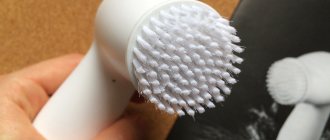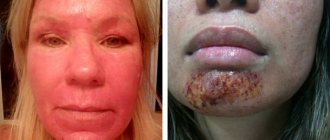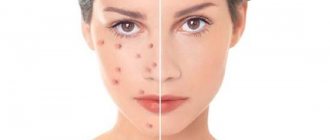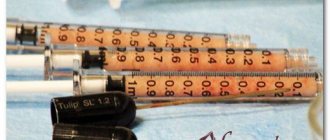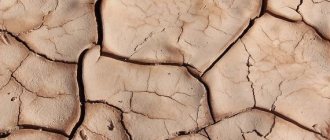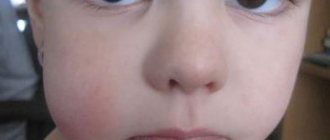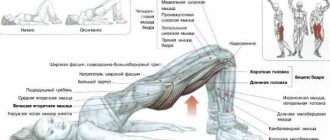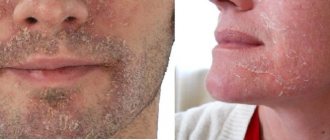What is an ingrown hair?
The surface of the skin is normally covered not only with hairs, but also with particles of dead epidermis, which lingers a little on top. As a rule, these tiny particles fall off on their own; sometimes this process is delayed, which leads to the formation of a crust that covers the surface of the hair follicle.
A hair grows from the bulb; if it is covered with a crust, then the rod cannot find a way out and remains under this crust. It cannot stop growing, nor can it get out, so it continues to increase in size under the skin, or is sent back to the bulb.
This whole process is accompanied by severe redness, itching, discomfort, and sometimes low-intensity pain. The area of skin surrounding the follicle may become inflamed, and a decrease in the rate of beard growth in this area is observed.
Important! Dermatologists refer to this problem as curled hair growth, because outside the free space, the hair shaft is forced to grow, twisting in a spiral.
What signs indicate the appearance of ingrown hairs?
The appearance of ingrown hairs can be determined by a number of signs:
- the appearance of a tingling sensation;
- severe itching;
- swelling;
- redness of the skin;
- the formation of a lump, in the center of which the head of a hair may appear;
- discharge of pus, appearance of a rash (in especially difficult cases when a bacterial infection is attached).
Sometimes the development of an ingrown hair can be confused with acne. Very often, bumps that form on the surface of the skin resemble pimples, especially when they are filled with pus. Even the slightest touch to the inflamed point can cause obvious pain.
If you leave the process unattended, there is a high probability that an ingrown hair cyst will develop deep under the skin. The only way to get rid of it is through surgery.
It is difficult and dangerous to remove a deeply hidden rod on your own; this can cause infection, leaving scars, scars; if such a situation arises, it is preferable to immediately contact a specialist.
Heredity factor
Diseases that lead to hormonal imbalance in the body, resulting in the formation of excess testosterone, which is the main reason for increased hair growth in women.
An imbalance can also occur during puberty in girls, as well as during menopause and pregnancy.
If the cause is established and the correct treatment is prescribed, the problem will be solved: the hairs will grow less intensively and subsequently disappear completely. But in the case where there is no disease or the use of drugs does not bring results, the only way to get rid of hair is to remove it.
Causes of the problem
The situation when beard stubble grows in is familiar to many people. Let's try to figure out what factors influence the development of this pathological process.
Causes of ingrown hairs:
- Improper shaving, in particular, neglect of mandatory care procedures before and after using the razor or other device. Shaving, in principle, dries out the skin and injures it; if you perform manipulations more often than once every 3 days, the skin will suffer greatly.
- The desire to shave the surface of the face clean, not to leave a single stubble, to get perfect smoothness. The harder a man presses on the machine, the more the blade removes not only the hairs, but the top layer of the epidermis, thereby depriving it of valuable moisture. If the hairs are cut very deeply, the likelihood that they will continue to grow not on the surface, but under the layer of the epidermis, increases.
- Machines with multiple blades are considered especially harmful. They work as follows: the first blade lifts the bulb, the second cuts off the shaft, the third removes the layer of skin that is protective and contains lubricant, and also removes the part of the shaft that is located below the skin. After only 2-3 hours, the tissue begins to fade, closing the mouth of the hair follicles, changing the direction of growth of the bristles.
- Rushing during the facial cleansing procedure can cause this problem. The fact is that you can start working with the machine no earlier than the skin is properly prepared. This preparation includes steaming with a hot cloth or water; it helps the epidermis become elastic, moisturized, and the muscle layer lose excess tension. This approach will avoid accidental damage to the skin.
- The problem of ingrown bristles often develops when a man moves the razor against the direction of hair growth, uses an electric razor (it does not take into account the direction of bristle growth), or does not monitor the sharpness of the blades and their timely replacement with new ones.
- After shaving, it is especially important to soothe irritated facial skin. For this purpose, the use of nourishing, soothing, moisturizing lotions, creams, gels, and balms is indicated. In addition, it is important to periodically use a scrub on the surface of the face to remove the stratum corneum and prevent the appearance of ingrown hairs.
- Wearing clothes with a hard collar, which constantly scratches the skin, can seriously worsen the condition of the epidermis. This factor can provoke infection of those areas of the face that are already inflamed.
What to do with ingrown hairs?
If the problem of ingrown vegetation cannot be avoided, everything possible should be done to correct the current situation. When there is no infection inside the formed lump, you can use one of the methods below.
Methods for getting rid of ingrown hairs:
- Make a compress from herbal decoction. It is possible to prepare a decoction of chamomile, parsley or other herbs that have disinfectant properties. Dip a soft cloth into the prepared, slightly cooled broth, then apply it to the surface of the face. After 10 minutes, the hair can be removed using tweezers (this must be done first to avoid infection). Wipe the damaged area of skin thoroughly with an antiseptic.
- It is not recommended to remove an ingrown hair; it will be much more useful to massage it without unnecessary pressure. To increase its effectiveness, you need to use a scrub, repeating the effect after 1-2 days. You can use a store-bought scrub; it’s not difficult to prepare a homemade version containing coffee grounds, olive oil and a small amount of shower gel.
- The use of salicylic acid will disinfect the inflamed surface, in addition, it helps prevent the formation of scars. Using acid, wipe the affected surface, repeating the effect several times a day. After 4-5 days, the hair will become free and the redness will disappear.
- You need to stop shaving with a razor for a while, or carefully avoid the affected areas. This is necessary so that the skin calms down and does not additionally receive mechanical injuries. For the same reason, you should avoid wearing clothes with a stiff collar.
Self-hair removal can be carried out only if there are no signs of the development of an inflammatory process (the skin area does not contain obvious redness, swelling, or oozing pus). Otherwise, it is better to entrust this procedure to professionals.
How to get rid of ingrown hairs
Greetings friends! Today is a very important topic that directly concerns growing a beard. What are we talking about?
Someone wants to grow a beard, but cannot because facial hair does not grow. But there are also those who cannot do this because they have ingrown facial hair! This thing is quite disgusting! And today we will find out how to deal with this.
Go!
As the name suggests, ingrown hairs are hairs that have grown into the skin!
Most of your skin contains hair follicles. Even in places that look smooth. Basically, hair is everywhere. Face, scalp, chest, arms, back, legs, etc. everything is covered with hair in both men and women. The areas you shave are the most susceptible to ingrown hairs.
The first signs that indicate ingrown hairs are a tingling and itchy sensation. Later, if you see swelling and redness; a bump with a hair in the center is a visible sign of an ingrown, inflamed hair.
Sometimes you may have pus coming out of the area described, or it may just look like a rash. Symptoms of ingrown hairs vary depending on how the hair grows into the skin, whether the lesion is infected, and how deep. Sometimes only the surrounding skin is infected, but sometimes the infection can spread deeper into the hair follicle.
Other factors such as genetics, lifestyle and overall health may also influence symptoms.
The symptoms of ingrown hairs can easily be confused with acne, because... they are very similar. Pus-filled bumps and boils very often look like pimples, which people with acne suffer from, causing severe pain when touched.
An ingrown hair cyst is inflamed deep under the skin and cannot be easily removed with tweezers. To remove deep inflammation, surgical intervention is recommended, since the hair is deep and will not just come out. The operation always leaves a scar or small mark, and there is also a risk of infection. If you don't want to end up with a keloid scar or uneven skin pigmentation, don't try to operate on yourself! Go to the right place! To the doctor!
It may happen that your doctor does not have enough information on how to get rid of ingrown hairs permanently. Sometimes doctors have problems determining the diagnosis. People may simply confuse the symptoms of ingrown hairs and acne. You will most likely be sent to a dermatologist. But even a dermatologist can get it wrong! Remember this. You definitely need to do a test and find out what kind of infection is in your skin. Fungal or bacterial.
The infection that causes ingrown hairs can be divided into two groups.
- Ingrown hairs caused by infected follicles
- Ingrown hairs causing secondary skin infection
In general, you may not have any infection and the pus you see is sterile. It could appear as a reaction of your immune system to an irritant. In this case, the irritant is ingrown hair.
Doctors often prescribe antibiotics because they are convinced that symptoms are caused by infected skin, which is not always the case.
If you suffer from ingrown hairs chronically, then you need to look for a deeper reason why you are experiencing these symptoms over and over again. Poor health is not just an unfortunate coincidence.
It is necessary to find out and eliminate what is the cause, and not eliminate the symptoms over and over again.
There are a huge number of reasons why hair begins to grow into the skin . To quickly get rid of ingrown hairs, it doesn’t hurt to find out the cause.
Typical reasons:
- Very frizzy hair
- Dry skin
- Bacterial or fungal infections
- For shaving (in most cases with machines with many blades), a straight razor is much better
- Hair removal using wax or tweezers
- Friction on clothes
- Chemicals that irritate the skin
- Sebum, dirt, oily skin, cosmetics and pore-clogging skin care products
For example, working in a fast food restaurant where you are exposed to oil fumes from the fryer every day. Another example. Working with chemicals that come into contact with the skin (paint for example) or soldiers wearing respirators. Even wearing a tie or a helmet with a strap can cause ingrown hairs due to friction and pressure on the skin.
Hair can become ingrown in two different ways. It can grow straight without problems and then twist and stick into the skin, or it may simply not have time to grow out of the skin. The skin closes over the hair and it is trapped. After this, inflammation begins.
Many people have a skin type that easily allows ingrown hairs to form.
The natural process of skin renewal slows down with age, as does the secretion of sebum, and for some this process occurs to a greater extent, and for others to a lesser extent. The result is that the dead skin cells on the outer border interfere with normal hair growth. The skin simply becomes rougher. Lack of skin hydration contributes to this in the best possible way. But not only because the skin is dry as such. Dry skin becomes weaker and more susceptible to infection.
During the inflammatory process, hair growth slows down. Instead of a hair, you may see just a black dot in the center of the swelling (if you have dark hair); This is the tip of the ingrown hair that can remain in place for many days instead of growing like normal hair.
You may also see several thin hairs forming one thick hair, or just abnormally thick hair. Such hair is so thick that it simply does not fit into the pore opening in the skin.
As you read earlier, there are other causes of ingrown hairs. but those mentioned above are the most typical.
Next, you will learn what to do to get rid of ingrown hairs once and for all.
Before you start getting rid of any ingrown hairs, make sure you don't have an infection in your skin. If an infection is present, there is a risk of the infection spreading to other areas of the skin. A dermatologist must cope with the task and find out the presence of infection. If detected, you will most likely be prescribed a course of antibiotics.
All of the above applies to serious cases when the affected area is not limited to a couple of ingrown hairs. If you only have one or a couple of ingrown hairs, then you most likely just want to get rid of it quickly.
As mentioned earlier, removing ingrown hairs on your own is not recommended. But if the hair is easy to remove with tweezers without damaging the surrounding skin, then you can try. In all other cases, consult a doctor, as digging into the inflamed skin can leave scars or cause an infection.
By the way, ingrown hairs very often have a different color and texture compared to the surrounding hair (several hairs form one, abnormally coarse, extremely thin, albino white, jet black, etc.)
If you can pull out an ingrown hair without feeling pain or resistance, it is a sign of an inflamed follicle. Normally, you would feel pain when pulling a hair, especially if it is a beard hair (since beard hair is coarse).
If there is no pain or resistance, then there is a possibility that the hair is not attached to the follicle at all. Under normal conditions, hair also falls out, but in special cases, such as infection, the hair loss may increase. In other words, the body itself is trying to get rid of the hair. The immune system sees it as a foreign body. We can observe approximately the same thing when there is a splinter in the finger. The formation of pus is part of this process and after the foreign body leaves the body, the amount of pus decreases as well as other symptoms (pain, swelling and discoloration of the skin).
If you often suffer from inflammation of the follicles, then there is a special name for this - Folliculitis.
It may also be similar to Pseudofolliculitis . It is usually mistaken for acne, but if it is acne, a different treatment approach is required.
- First, you need to wash your hands and the affected area very thoroughly. Preferably a product that has antimicrobial properties. If this is not the case, then you need to sterilize the surfaces with additional means. You also need to sterilize your instruments (with fire or alcohol, for example).
- Those hairs that are completely under the skin are much more difficult to remove. Surgery is required, consult a doctor. If you see the tip of the hair, then carefully try to pull out the ingrown hair with tweezers, but do not pull. You need to keep your skin intact. If your hair doesn’t respond, then don’t even think about doing micro-surgery yourself!!! Scars, infection or discoloration of the skin are of no use to you!!!!
- Those ingrown hairs that curl back and dig into the skin do not require complete removal, since only the tip of the hair causes the problem. Try to remove the tip of the hair with sterilized tweezers, then cut off the excess from the hair. The problematic tip is usually thinner than the base of the hair. Now, hair with a wider base is less likely to get into the pores of the skin again.
- Wash the affected area again, first with warm water with a small amount of antibacterial agent, then with cold water to close the pores. Cold water will also reduce redness caused by inflammation. Then gently pat your skin dry with a clean towel.
- Use a non-comedogenic face cream (i.e. not for oily skin as it will be drying). Keep your skin hydrated to keep it supple. This is especially true during the dry winter months. Remember, dry skin is one of the most common causes of ingrown hairs.
The recommendations above are, of course, only ways to get rid of ingrown hairs here and now, and will not prevent the possible further formation of ingrown hairs. After removing one hair, another will grow in its place and, most likely, according to the same scenario. Therefore, it is very important to take preventive measures to prevent ingrown hairs.
Prevention is always better than cure. There are some tips on how to do this.
- Avoid skin care products that cause ingrown hairs.
Perhaps you are using the wrong cosmetics? Here are a few things to keep in mind:
- Your shaving cream/gel, aftershave and cosmetics (if you use them) may contain comedogenic ingredients that clog pores and block normal hair growth. Suitable care products must be used. And it's quite difficult. After all, you need to maintain a balance between the aggressiveness of the cleanser and the dryness of the skin. So the next question arises...
- Is your product too gentle or too aggressive? Your skin has a natural coating that serves as a natural defense against chemicals, bacteria and microorganisms. Products containing, for example, alkali, negatively affect the natural coating, leaving the skin defenseless.
- Avoid aftershave products that contain alcohol (especially if you already have dry skin). The alcohol will dry it out even more. Yes, it will reduce the amount of bacteria on your face and will also benefit some of the water insoluble actives, but it will strip away the sebum. It is sebum that keeps the skin hydrated and elastic.
2. Shaving technique and prevention that reduces the risk of ingrown hairs.
In general, the best option is not to shave at all and grow a beard (if you are a man and we are talking about your face). If not, then pay attention to the following checklist.
- Shaving habits.
Don't shave against the grain. Surely you've heard this advice before? Shaving against the grain of the hair gives a closer shave, and that's true. But at the same time, such a close shave can cut hair below the skin level and the skin can simply grow over it, leading to an ingrown hair. On the other hand, you can shave against the height, but the following factors should be taken into account: - Avoid dry shaving and electric shavers with hair lifting systems
- When using electric shavers, make sure that the cream or gel creates enough slip between the skin and the stationary parts of the razor.
It is important to follow shaving guidelines, especially if you have curly hair. Since they do not grow straight, therefore, there is a greater risk of ingrown hairs after a close shave.
- Peeling.
Most tips and methods for dealing with ingrown hairs are based on detachment. Why? Because dead exfoliated skin with oil and dirt does not prevent hair from growing normally, but this is not always enough. Exfoliators are often recommended for getting rid of ingrown hairs as they help unclog pores and prevent ingrown hairs from growing into the skin. There are two ways to exfoliate: physical and chemical. Products made specifically for exfoliation contain acids and granules that can damage the skin. After which the risk of infection increases and you can end up even worse than you started. Not the best solution! - Depilation.
Wax and tweezers are not something that is typically used when removing large amounts of facial hair (an entire beard, for example). But with other parts of the body it’s a common occurrence. So, by using the above methods, ingrown hairs can be avoided. It is very important to prevent bacteria or microorganisms from entering the skin after hair removal. Natural antimicrobial agents are more preferable, since in some cases you have to deal with very delicate skin. Use an antimicrobial product both before and after hair removal. Once the hair begins to grow back, usually after a couple of weeks, you can begin using exfoliators to prevent hair from growing into the upper layers of the skin. Hair growth depends on many factors (part of the body, age, gender, nutrition, even time of year). Itching of the skin a couple of weeks after hair removal is one of the signs that the hair is approaching the surface of the skin and it’s time to exfoliate the skin (clear the way, so to speak)
The cases described earlier do not cause major problems, since the causes are common. But there are many puzzling cases where there is no obvious cause for ingrown hairs. It is important to remember that a weak immune system reacts violently and sharply to irritants (any kind, not just an inflamed bulb and ingrown hairs). This partly explains the fact that some do not experience any problems at all, and some experience one after another.
Eliminating the direct cause is a good idea, but regulating the abnormal immune response is a better way to normalize the situation, especially if you have recurring symptoms. But in this case, consultation with a doctor is required.
The information presented in this article is advisory in nature. Friends, if you are not 100% sure of what you are doing, consult your doctor!!
I hope you found it interesting and learned something useful! I will be very grateful if you share it with a bearded friend who will appreciate the article, thereby greatly helping the development of the Life4Beard.ru project
P.S. Liked it - Subscribe!!!
See you later!
How to avoid ingrowth?
There is no solution to the problem of ingrown hairs as such. There are only a few steps you can take to help reduce the likelihood of a problem occurring.
Important Tips:
- let go of your beard: neatly trimmed stubble will avoid the need to constantly shave, which will remove the most important factor that provokes the formation of ingrown bristles;
- Before shaving, be sure to use a scrub, which must be rubbed with massage, circular movements into the surface of the face for 2-3 minutes;
- Be sure to prepare your facial skin for hair removal by steaming it, using appropriate cosmetic products, and soothing the skin after the procedure;
- in order to soften the hard structure of the hair, you can wash it before shaving with hot water and soap;
- use devices that have only one blade, promptly replace a dull tool;
- shave your face in one pass, moving the razor from the cheeks to the jawline;
- Shave your neck also in one movement, moving upward, towards the jawline;
- move the blade over one area only once;
- avoid strong tension on the skin while manipulating the razor.
If the above methods do not give a positive result, you can use chemical depilators to remove hair. Their use requires caution; many cause serious allergies and irritation of the surface of the face. Chemical products are not suitable for daily use.
As an alternative to the machine, you can use a shaving machine; it does not cut the shafts so short. An electric razor is not suitable for this purpose; it gives the same effect as multi-blade razors.
Ingrown beard hairs are a common occurrence that can be difficult to get rid of. However, every man is fully capable of preventing the development of the problem; the main thing is to organize proper facial skin care and carry out the shaving procedure strictly according to the rules.
Causes of hair on the chin in women
Pathology when vegetation appears on the body in places uncharacteristic for a given gender is called hirsutism. In women, dark hair can grow on the chin, chest, cheeks, area above the upper lip, stomach, back, inner thighs, arms, legs. In some cases, it is vellus hair, in others it is shaft, thick hair.
Hormonal imbalances are the main cause of this phenomenon. Doctors associate the development of hirsutism with an excess of male hormones, mainly testosterone, or a lack of female hormones - estrogen.
If the darkening of vegetation occurs suddenly, the impetus for this is:
- Pregnancy. A pregnant woman's hormonal levels change significantly, but after childbirth the situation most often returns to normal.
- Stress. It also causes disruption of the endocrine system.
- Taking medications. These include, first of all, hormonal drugs and oral contraceptives. It is strictly not recommended to buy the first COCs you come across without first passing tests. You should also not take pills without a specific schedule. Otherwise, hirsutism is the most harmless of the possible consequences.
- Use of cosmetics. Cosmetics, in particular face cream, contain substances that stimulate hair growth and pigmentation - lanolin and vegetable oils. In some cases, the reason is the use of cosmetic products intended for older women by young girls.
- Climax. With the onset of menopause, ovarian function fades, the production of female hormones stops, and testosterone, on the contrary, begins to be produced more actively.
- Puberty. A hormonal surge triggers many processes in a growing body, including increased hair growth.
- Unfavorable environmental situation.
- Oncological diseases. Hormonal imbalances occur as a result of the development of hormone-producing tumors and gynecological diseases, such as polycystic ovary syndrome. The appearance of dark hair on the chin causes dysfunction of the pituitary gland, on which the functioning of the internal secretion organs depends: adrenal glands, thyroid gland, pancreas.
An increased concentration of testosterone is accompanied by characteristic symptoms:
- deepening of the voice;
- increase in muscle mass;
- irregular periods.
Heredity is also one of the main reasons why hair grows on the chin in women. Hirsutism is more common among brunettes and dark-skinned representatives of the fair sex, that is, women of the Caucasian and Mediterranean type. However, even in this case, it is necessary to exclude the possibility of hormonal imbalance by taking tests.
When signs of hirsutism occur in relatives, hormonal treatment will not give a significant result. The best option is to remove vegetation by physical means.
Only after determining the reasons that caused hair growth on a woman’s chin is treatment prescribed. But the pathology is a cosmetic defect, and hormonal treatment does not give immediate results, so women who are faced with this problem should learn how to get rid of unwanted hair in other ways.


